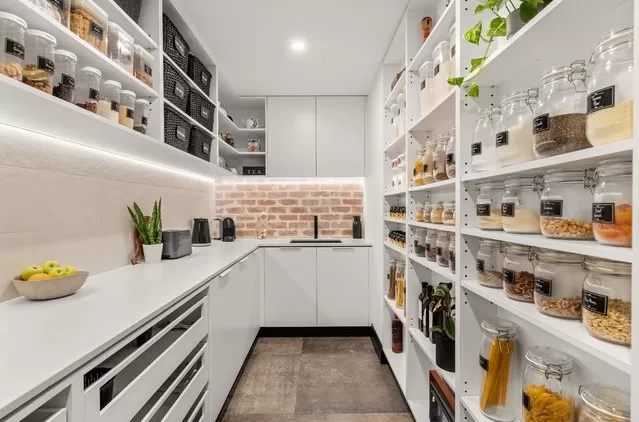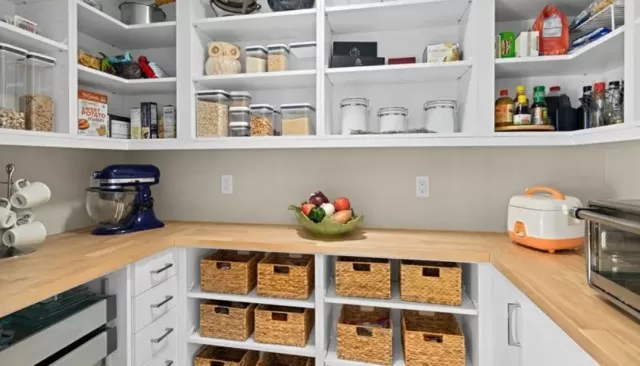Explore these kitchen pantry design ideas to enhance the functionality and organization of your kitchen.
When it comes to storage solutions, a well-designed kitchen pantry is a valuable asset.
Whether it’s a built-in, butler’s style, walk-in, freestanding, or a combination of these, a pantry serves the purpose of efficiently organizing and consolidating everything you need in your kitchen. With the right pantry design, you can keep your food items neatly arranged and easily accessible.
How to Choose a Kitchen Pantry

When choosing a kitchen pantry, there are several factors to consider.
First and foremost, assess the available space in your kitchen and determine the size of the pantry that will best fit your needs. Consider the amount of non-perishable food you typically store and ensure that the pantry has adequate shelves and compartments to accommodate your inventory.
Another important consideration is the pantry’s organization and accessibility.
Look for pantries with adjustable shelves or modular storage systems that allow you to customize the layout to suit your preferences. This will help you maximize the use of space and keep items well-organized, making it easier to find what you need.
Consider the pantry’s design and aesthetics as well.
Choose a style that complements the overall look of your kitchen and blends seamlessly with your existing cabinetry and decor. This will create a cohesive and visually appealing space.
Additionally, think about the pantry’s functionality and features.
Look for pantries with easy-to-open doors or sliding mechanisms for smooth access to your stored items. Consider additional features such as built-in lighting or pull-out drawers for added convenience.
Finally, take into account your specific storage needs.
If you have a large collection of spices, look for pantries with built-in spice racks or designated compartments. If you frequently use Small Appliances or have bulk storage requirements, consider pantries with adjustable shelves or pull-out baskets to accommodate these items.
By carefully considering these factors and selecting a kitchen pantry that suits your storage needs, organization preferences, and design aesthetics, you can create a functional and efficient space for storing your non-perishable food items and food preparation essentials.
Kitchen Pantry Storage Ideas

Discover innovative ideas for organizing your reach-in pantry and ensuring that your food items are fresh and easily accessible.
Thoughtful designs for reach-in pantries allow for efficient storage of canned goods, dried goods, small appliances, and tableware. By incorporating shallow, angled shelves, you can maintain the visibility and organization of smaller items, preventing them from getting lost among larger items.
Adding a whiteboard surface on the inside of the pantry door creates a convenient space for jotting down meal plans and grocery lists.
Utilize custom-fit upper shelves in your small kitchen pantry to maximize storage space for spices and dishware.
Mount racks underneath the lowest shelf to hold wine glasses, and attach slim shelves to the backs of the double doors to store oils, vinegar, and wine bottles. Deep drawers and open cubbies can be used to store beverages and other pantry items, while a tabletop surface can house appliances like an espresso machine.
Consider incorporating a spacious butler’s pantry located off the kitchen to keep small appliances, serve ware, and food items out of the way.
Install a long, shallow counter to provide an extra work surface and additional storage space. Use open drawers below the countertop to hold pantry items, and add a rolling library ladder to access upper shelves that can store infrequently used serving dishes and cookbooks.
Make use of over-the-door storage systems to maximize the storage capacity of your pantry.
These systems can turn blank spaces into functional storage zones, allowing you to customize the unit with adjustable storage baskets to meet your specific needs.
Organize your walk-in pantry into zones for different categories of pantry items.
Designate specific shelves or sections for breakfast foods, snacks, beverages, dinner ingredients, extra paper products, and more. Use labels to clearly define each zone, making it easy for everyone in the household to find and put away items.
Opt for floor-to-ceiling cabinetry in your pantry to create ample storage space for kitchen essentials.
Consider a tall cabinet with shelves at different heights to accommodate various groceries, keeping them conveniently close to the food preparation area. Coordinating the pantry’s design with the rest of the kitchen, such as matching the dark-stained lower cabinets, can create a cohesive look.

Install a tall pullout pantry that acts as an extension of the refrigerator, consolidating dry goods and cold-food storage into one area of the kitchen.
This narrow cabinet slides out to reveal long shelves, providing efficient storage in a compact space.
For small pantries, maximize storage and organization by portioning snacks into bags and using food storage bins.
Clear plastic bins can be used to store cereal, pasta, and other dry foods for easy recognition. An over-door wire rack can also provide additional storage without overcrowding the shelves.
When organizing your pantry, focus on creating a neat and orderly presentation.
Consider adding a wooden wine rack to enhance the sophisticated look of your walk-in pantry. By intentionally placing food items, appliances, and cookware on clean white shelves, you can achieve a clean and presentable appearance.
Install a tall pantry with open shelving and cabinetry to increase storage capacity while adding a touch of elegance.
The 14-inch cabinet depth is ideal for storing dry goods and simplifies inventory management. To organize items on deeper shelves, use baskets or shelf dividers to keep everything in its place.
If space allows, consider placing a kitchen pantry cabinet in an adjacent area just outside the kitchen.
This creates more room for cooking while still providing ample storage space. Take advantage of the backs of doors by installing shelves for additional pantry cabinet storage.
Use pullout shelves to maximize every inch of available pantry space for food, supplies, and small appliances.
*The information is for reference only.